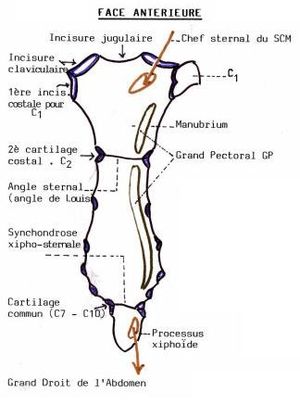Sternal punction (pediatry)
From WikiLectures
Indications[edit | edit source]
- hematopoietic disorders,
- oncological diseases: leukemia, lymphoma, neuroblastoma,
- thesaurisms,
- diseases of the macrophage system: histiocytosis.
Contraindications[edit | edit source]
- There are no contraindications to bone marrow collection (in the case of inflammation of the skin over the injection site, we choose a different collection site).
Bone marrow aspirate is used for morphological examination of the developmental line of blood cells, i.e. differential cell budget in panoptic staining, and for special examinations. Special tests include histochemical staining to determine enzyme activity or PAS reaction for glycogen content.
In recent years, immunological examination (presence of CD-antigens on the surface of white blood cells) and cytogenetic examination have become the basis of differential diagnosis.
Progression[edit | edit source]
- Bone marrow is taken from the tibia in children up to 2 years of age, from the sternum in children > 2 years of age (it can also be obtained from other places, e.g. from the anterior and posterior ridges of the hip bone, from the projections of the vertebral bodies or from the femur),
- adequate analgesia is advisable before collection,
- the skin at the injection site is widely disinfected as before surgery, and sterile surgical gloves are worn,
- infiltrate the subcutaneous tissue at the injection site with a thin needle, approximately 2 to 3 ml of 1% Mesocaine as close to the periosteum as possible
- wait 1 to 2 minutes after spraying,
- we use special bone marrow aspiration needles, 18 to 19 G for larger children and 21 to 22 G for smaller children,
- The needle has a mandrel and a screw-on, adjustable stop,
- adjust the needle stop to the estimated distance (approx. 2 cm for larger and 1 cm for smaller children); the stop is used to prevent unintentional abnormally deep puncture,
- penetrate the skin with the needle, preferably from an oblique angle, then set the needle perpendicular to the bone:
- at the tibia in the upper third on the anterior wall, between the fingers of the other hand, which fix the tibia by holding it by both fingers,
- sterna to the manubrium sterni at the imaginary intersection of the perpendiculars of the middle of the jugula and the 2nd intercostal space,
- with a gentle helical movement and constant slight pressure, insert the needle into the bone marrow, the resistance of the bone is significantly decreases after reaching the marrow, the needle holds itself firmly in the bone,
- remove the mandrel and aspirate the bone marrow with a 20 ml syringe,
- stop aspiration when several drops (max 0.5 to 1 ml) of bone marrow appear in the syringe and are macroscopically indistinguishable from blood,
- remove the needle and syringe, cover the injection site aseptically and compress with gentle pressure for 3 to 5 minutes,
- immediately after aspiration, we distribute the bone marrow onto a prepared degreased slide and smear it on at least 5 to 10 additional slides (for immunological or cytogenetic examination it is necessary to aspirate more marrow and inject the aspirate into non-coagulating media),
- In some special indications (especially in oncohematology), so-called trepanobiopsy is also performed, where the marrow is not aspirated, but a whole marrow sample with bone matrix is obtained.
Complications[edit | edit source]
- Bleeding in thrombocytopenia or coagulopathy.
Links[edit | edit source]
Source[edit | edit source]
- HAVRÁNEK, Jiří: Sternální punkce.



